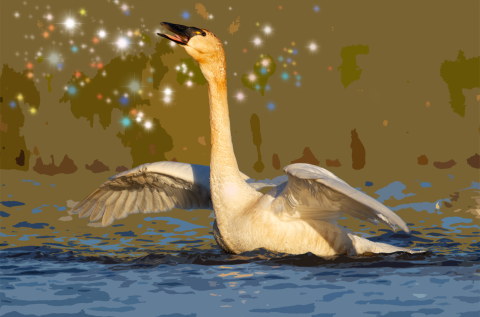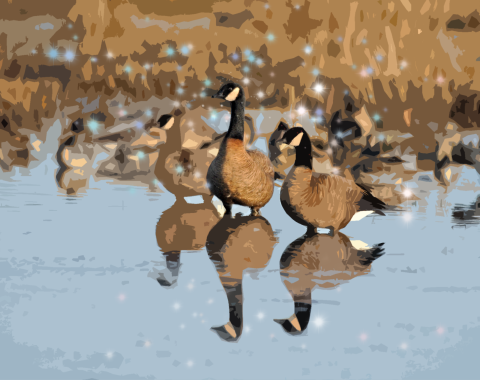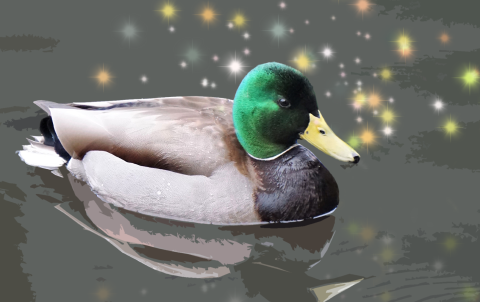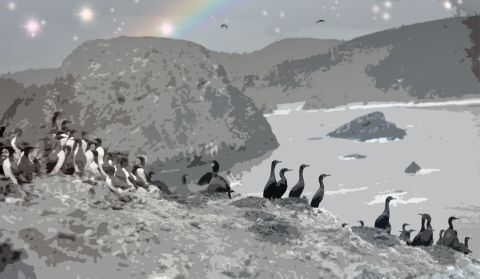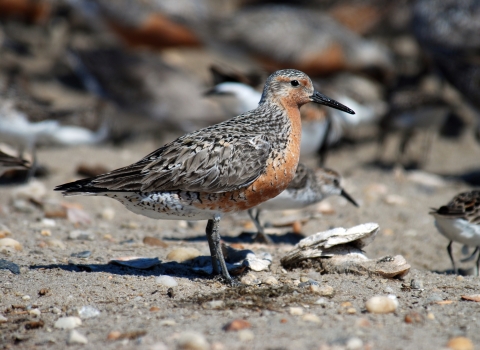It’s fall: our favorite season to watch migratory birds fly south to escape the upcoming chill. The Pacific Northwest is in the Pacific Flyway, a bird migration corridor on the west coast of the United States, Canada and Mexico. Migratory birds pass through the Pacific Flyway and many rely on the U.S. Fish and Wildlife Service’s National Wildlife Refuges. This network of protected public lands and waters provides safe places for birds to rest, eat, nest, and raise their families. While all 47 refuges in Oregon, Washington, and Idaho are great for birding, below are six places you can find birds recharging for the rest of their journey south or feathering down for the winter.
Tundra swans at McNary National Wildlife Refuge: If you visit McNary National Wildlife Refuge in November, you’ll likely see large flocks of long-necked tundra swans foraging in the seasonal wetlands. Tundra swans migrate long distance, flying from their summer breeding grounds in the Canadian and arctic tundra and wintering on the Pacific coast. Tundra swans can be found at McNary through April, taking advantage of the 15,000 acres of sloughs, ponds, streams, and islands. The refuge also has upland shrub-steppe habitat that provides cozy homes for migratory waterfowl, shorebirds, and songbirds. Up to 60,000 snow geese also visit the refuge from November through May, leading to white-out conditions!
Bald eagles at Kootenai National Wildlife Refuge: Located in Northern Idaho near the Selkirk Mountains, Kootenai National Wildlife Refuge provides a year-round playground for bald eagles. The bald eagle is a symbol of success for the Endangered Species Act, and have recovered from near extinction to robust populations nationwide. Bald eagles love lounging at Kootenai, where they can find a diverse habitat of wetlands, meadows, riparian riparian
Definition of riparian habitat or riparian areas.
Learn more about riparian forests, and cultivated agricultural fields to nest and hunt. If you plan to go hiking this fall, consider carrying a can of bear spray – Kootenai is bear country.Dusky Canada geese at William L. Finley National Wildlife Refuge: When fall colors rise and leaves start to fall, we know that we’ll find dusky Canada geese in the Willamette Valley. Established in 1964, William L. Finley National Wildlife Refuge provides prime wintering habitat for dusky Canada geese, who have a more limited summer and winter range compared to other waterfowl. Water levels are intentionally raised in the fall and winter to maximize food availability for geese, and the refuge’s wetlands and wet prairies provide a homey resting area. Dusky Canada geese can also be found at the other national wildlife refuges in the Willamette Valley refuge complex, including Ankeny National Wildlife Refuge, Baskett Slough National Wildlife Refuge, and the newly established Willamette Valley Conservation Area.
Ducks at Deer Flat National Wildlife Refuge: If you live in Idaho’s Treasure Valley and need a quick autumn birding fix, Deer Flat National Wildlife Refuge provides habitat for a spectacular array of wildlife, including ducks. Mallards pass the long fall and winter hours on the open water and wetlands of Lake Lowell, and they pal around with wigeons, northern shovelers, gadwalls, northern pintails, and green-winged teals. Deer Flat also provides one of the few nesting areas for western and Clark’s grebes in Idaho, which may be harder to spot in the late fall. Because of its value to birds, the refuge has been declared an Important Bird Area by the National Adubuon Society. Deer Flat is one of the many refuges near growing urban areas in the Pacific Northwest, including Billy Frank Jr. Nisqually, McKay Creek, McNary, Ridgefield, Steigerwald Lake, Tualatin River, and Turnbull National Wildlife Refuges.
Seabirds at Oregon Islands National Wildlife Refuge: Planning a fall road trip down the Oregon coast? You’re likely to see part of the Oregon Islands National Wildlife Refuge, which spans the entire coast and includes wilderness islands and windswept headlands. This national wildlife refuge national wildlife refuge
A national wildlife refuge is typically a contiguous area of land and water managed by the U.S. Fish and Wildlife Service for the conservation and, where appropriate, restoration of fish, wildlife and plant resources and their habitats for the benefit of present and future generations of Americans.
Learn more about national wildlife refuge includes 1,853 rocks, reefs and islands, and most of Oregon’s estimated 1.2 million seabirds use the refuge as habitat. Cormorants, black oystercatchers, murres, loons, and the ever-present gulls can often be spotted as the weather turns colder. Don’t forget to bring your binoculars and rain gear!Shorebirds at Grays Harbor National Wildlife Refuge: Nestled near the coast in Hoquiam, Washington, Grays Harbor National Wildlife Refuge is a popular waystation for migrating shorebirds in the fall and spring. Dunlins are out in force by late October, and visitors are also likely to see least and western sandpipers and black-bellied plovers. If you bring your hiking shoes, you can take the Sandpiper Trail through a salt marsh salt marsh
Salt marshes are found in tidal areas near the coast, where freshwater mixes with saltwater.
Learn more about salt marsh for the shorebirds, and then continue on through a patch of alder and cottonwood to hear the calls of resident songbirds



